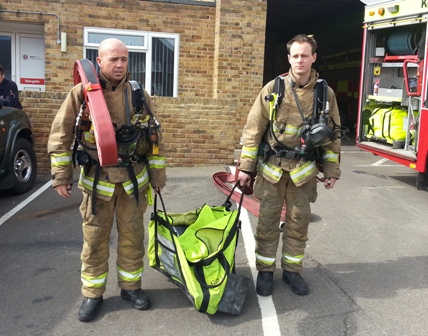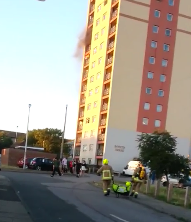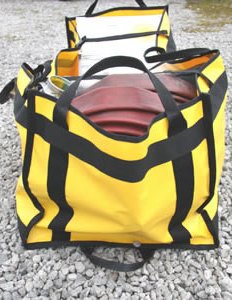Click on Images to enlarge
| Pic:Ruthlee.co.uk | Pic:Francic Summerfield (YouTube) | Pic:Ruthlee.co.uk |
A (high rise) load bag is basically a bag designed to help fire-fighters move equipment through a high-rise building.
Historically equipment was carried by hand, under arm or tucked into tunics. It was piled up in lifts, lobbies and stairwells. Moving the various objects would take multiple return voyages to the appliance carrying the equipment to the various staging points.
To help with this problem a load bag was developed and trailed. It was loosely based on the helicopter load bags that various UK FRS use for their Marine Operations (ship fire fighting). It was designed to be carried by 2 to 4 fire-fighters and should be small enough that it can be manoeuvrable up stairwells. The material on the bottom is reinforced to allow it to be dragged. To be safe (MAC manual handling) for two fire-fighters to use the load is usually limited to around 45Kg. This is suitable for two firefighters in full PPE wearing BA sets.
 |
 |
Pic:Highrisefirefighting.co.uk
Load Lists
Another great advantage of using load bags is that it enables pre-designated loads to be sequentially brought to the forward control point (Bridgehead).
There are some basic necessities that should be located at the bridgehead to support operational deployment. These will usually be designated following a pre-incident risk and intelligence inspection (SSRI). Load lists for the specific risks on a station ground should be kept in the load bags, if possible. Also a copy of the building specific load lists should be available at the Bridgehead so the Bridgehead Commander can assess what equipment will bereceived and alter it as the incident dictates.
Below are a set of typical risk specific load lists for the first 4 appliances:
LOAD LIST 1 (First pump) 1 JO + Minimum 2 CREW
|
LOAD LIST 2 (Second CREW)
2 CREW MEMBERS
|
LOAD LIST 3 (Third CREW)
1 JO + Minimum 2 CREW MEMBERS
|
LOAD LIST 4
Minimum 2 CREW
|
The use of light weigh hose is highly recommended for High rise incidents as it will reduce the overall weight of equipment being taken to the incident floors. This is especially important if the lifts can not be used. Hose should be bade up in a Carmel style and can be carried over shoulder, over Cylinder or in the load bag.


